Company Hierarchy in Japan

by Madelaine
Taking your first steps in the Japanese business world and feeling overwhelmed by the corporate hierarchy? When starting my first job in Japan I tried looking them up, but they all seemed to vaguely translate to something like section or department manager… Here I share with you what I learned since then.
Why hierarchy matters (in Japan)
It’s hard to imagine a Japanese office where the structure and work culture isn’t dominated by the internal hierachy.
Be it in a meeting room, or an elevator, in business situations the seat or place of each person is decided by their standing in the hierarchical structure. This is not required at every firm, but when talking to a person from your company you might have to address them using their name and title, as in 田中課長 (Section manager Tanaka).
Failing to grasp the position of a person in the management hierarchy (役職, やくしょく) is disrespectful and may leave a bad impression. Further into the job, not understanding the place of everyone in the hierarchy at your company can cause confusion in who’s orders to follow and who to report to. To avoid such mistakes, I put together a list with the most common titles and their meaning.
Hierarchy from top to bottom
- 1.CEO, Chairman
-
会長 (かいちょう): the owner of the company, who will often not participate in day-to-day business, but lead the company from behind the scenes.
Average age: 65, 43 years in the company
※The data is only intended as orientation. It is not a national average, but the typical age of people in these positions at Toyota to give you an idea. - 2. President
-
社長 (しゃちょう): the face of the company, and the one making the final decisions in day to day activities.
Age: 60, 38 years in the company - 3. Director
-
取締役 (とりしまりゃく): responsible for the management of the company a as whole. He might also preside over a specific branch.
Age: 54, 31 years in the company - 4. Department/General Manager
-
部長 (ぶちょう): The head of a department and most likely the highest-up you will see around on a daily basis.
Age: 44, 21 years in the company - 5. Assistant General Manager
-
次長 (じちょう): similar to the 部長 in that he typically is in a leading position in the department, but one rank below the 部長.
Age: 40, 17 years in the company (※estimate due to lack of data) - 6. Section Manager
-
課長 (かちょう): leading one section within a department.
Age: 35, 13 years in the company - 7. Assistant Manager/Team Leader
-
係長 (かかりちょう): usually in charge of a larger team.
Age: 32, 9 years in the company - 8. Supervisor
-
主任 (しゅにん): someone with experience in what they are doing, and able to take a leadership role.
Age: 28, 5 years in the company - 9. Staff
社員 (しゃいん) or 平社員 (ひらしゃいん): Everyone else, the normal employees.
Nowadays, with English titles entering Japanese companies, the naming of positions in Japanese companies is getting increasingly diverse. While this development makes it easier for us foreigners to get an idea what everyone is doing, you will find that companies might use them in different ways or maybe even mix English and Japanese titles. In that case you can be sure that the Japanese people you start together with will be at least as confused as you yourself.
How about promotions?
Promotions in Japan for a long time have been depended on years of service. The longer one worked for a company the higher the chances to get a promotion.
Nowadays more and more companies adapt merit-based promotion systems, promoting those that achieve results regardless of age or background.
The best way to learn about the hierarchy and promotion system in your company is to ask a coworker or superior. It is something even Japanese recruits are not taught, and asking will signal your interest in the company and in fitting in.
Recommended Posts

How to Get Along with Your Japanese Boss
25 5月 2021 - Work, Working Culture

The 10 Most Popular Japanese Companies in 2021
19 5月 2021 - Work

